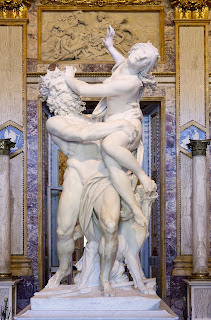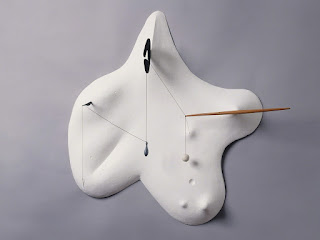X: The Artist's Hand
 |
| The Rape of Prosepina Bernini, 1622 |
 |
| Balloon Dog Koons, 2008 |
The discussion of “the artist’s hand” in the history of art has been a lengthy one with ever-changing opinions. Sculptors in particular deal with the inevitability of requiring studio assistants to complete their projects and it is this assistance that becomes the subject of scrutiny for many. I find that there has been an obsession with how works of art are made throughout time. Up until relatively recently there has been an effort to promote the illusion that every statue attributed to a particular artist was carved in its entirety by the sculptor themselves. The value of Bernini’s statues came from his personal supposed superhuman ability to render human flesh but in reality it wasn’t necessarily Bernini doing all of the carving. Does this shattering of the illusion devalue many works prior to the 20th century? I think not. Artists are very much like composers and conductors rather than the player of a particular instrument. Beethoven did not play every part of his Fifth Symphony, yet he wrote and conducted the orchestra himself much like how Rodin would make a clay model that would serve as the sheet music in this metaphor and command his carving assistants intermittently throughout the process of creation. Artists always knew it was the concept and their direction, no matter how removed, that made the work of art theirs but for the layperson it had been important up until recently to know that they are paying for the artist’s hand that has been involved in the work.
It has been through artists in the twentieth century that the public has moved away from the emphasis on the artist’s hand. The revolutionary work of Marcel Duchamp and other Dada artists in the early twentieth century and their application of the found objects like the readymade and, in a way, photomontage, was the opening of the flood gates so to speak. This tradition was expanded upon and revisited and revised by contemporary artists like Jeff Koons and Ai Wei Wei who use new technology and at the same time classically trained craftsmen to realize their concepts. To me, artists are carrying on how they always have; waxing between the importance of how something is made and the artist’s relationship to the work, and the importance of the finished product.
The artist’s hand was once the hallmark of a technically expertly executed work of art whereas nowadays, evidence of the artist’s hand is equivalent to charming imperfections and a human quality of the final product. This is not to say that either of those options is inherently better than the other because tastes will always be changing. However, with the influx of new technology being used to execute sculptures like Koons’ Balloon Dogs and those pieces being seen as an example of the commodification of art, many artists have given a bad connotation to the use of expensive and industrial processes and there is certainly a discernible trend favoring the handmade. With the growing demand of handmade works, one must assume that the influx has created a scarcity of that kind of work requiring these handmade-centric works to be created more and more by assistants. One could imagine that with time and the natural advancement of technology, there could be a move into a weird realm of pseudo-handmade work where the process is mechanized but with the advancement of mechanization allows for the work to be indistinguishable from actual human crafted final products.
#hadpratt, #hadsopratt, #hadstories, #hadhistoryofsculpture


Comments
Post a Comment